Laser Output as a function of time
From design point of view we can say that output of all lasers is not constant. Different types of applications require different types of lasers. Therefore the output from the laser can be altered by changing its magnitude over a period of time.
Thus the time related modes of laser operation are
Continuous wave (CW)
Modulated Wave
Normal Pulsed
Q- Switched
Mode locked
Continuous Wave Laser
A laser that are designed to produce a beam of constant amplitude are called continuous wave or CW lasers. The CW lasers are rated in power units of watts, milli & kilo watts.
A graph of the power output from the laser as function of time is shown as:

The line indicates that power is straight/constant. Any variation from the straight line would indicate that the laser is not stable. Ideally as shown in graph, the lasers have no variation but still there exist some variations usually very small
SincePower = energy / time
OrEnergy = power X time
Therefore the area below the line in graph represents the energy transmitted by laser.
Modulated CW laser
The laser that are designed to produce a modulated beam of amplitude (usually constant but may be vary) are called modulated C.W lasers.
The modulated beam can be obtained by either switching the laser ON and OFF rapidly (pulse modulation) or by varying the intensity of the beam (power modulation).
Graph showing the pulse modulation & power modulation of lasers

These types of lasers are mostly required in applications related to data communication.
Normal Pulsed Lasers
One disadvantage in the pulse modulated laser is that the excitation mechanism cannot continuously pump energy into the active medium. Now to overcome this disadvantage the normal pulsed laser is used.
In normal pulsed laser, the excitation mechanism is pulsed and the laser is produced for short time while the pumping energy is great enough to keep the active medium above the gain threshold. By diagram normal pulsed laser can be shown as:
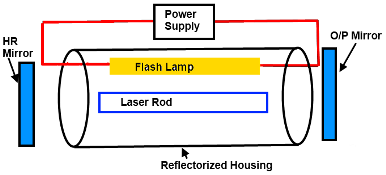
Energy curve for normal pulse laser is as
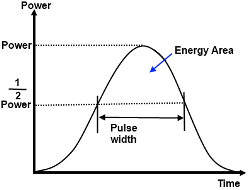
This graph shows output power for normal pulsed laser. The time duration of the pulse is called pulse duration pulse width and is measured at two half power point on the curve.
The pulse width for normal pulsed laser varies from 0.1 to 10 milli seconds.
Remember that for different applications requirement the shape of the pulse may be changed.
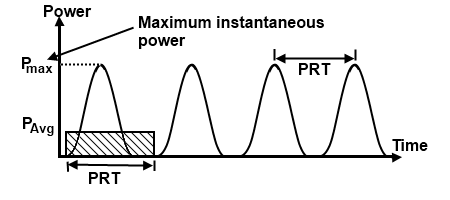
PRT Duty cycle of Pulsed Laser PRT
The PRT stands for "Pulse Repetition Time". The PRT represent the time for one complete ON-OFF cycle.This is also referred to as the period of the pulse
PRT = 1 / PRR
PRR = Pulse Repetition Rate
Duty Cycle
The duty cycle is the ratio of the beam's ON-time to the total PRT or cycle. It is the pulse width (as measured between the half power point) divided by the PRT and expressed as a percentage, therefore
Duty cycle = Pulse width / PRT
or
Duty cycle = (Pulse width / PRT)X 100
Note
Area under the single pulse curve represents the energy of that pulse. If the area under the single pulse is evenly distributed across the entire PRT then it represent the average poser, denoted by PAVG,as clear from above diagram.
Thus
Energy = PAVG X PRT
Q – Switched Lasers
Before discussing Q – switched lasers we will define Q & Q – Switch.
Q is the figure of merit for the resonant cavity within the laser. This figure of merit (Q) is defined as “the average energy stored in the resonator divided by the energy dissipated per cycle”. Laser can be made to produce high energy pulses by altering the Q of the resonant cavity. This is done by Q – Switch. The Q – Switch is a device that allows an active medium to be pumped until it contains the maximum amount of energy. It does this by switching the lasing action ON and OFF.
Now if the Q Switch is added between the HR mirror and output mirror of laser, then it result in Q – Switch laser, as shown
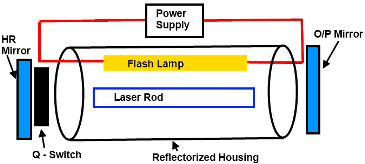
PRT Duty cycle of Pulsed Laser The Q – Switch (which is placed inside the laser resonant cavity) by itself is a high speed optical switch closing the switch defeats the feedback mechanism within the laser by stopping reflection between the laser’s mirrors. This naturally steps the lasers output. However excitation energy can still be pumped into the active medium. This is very much like charging a capacitor. This continued pumping of the laser causes an extremely high population inversion, so the energy is being stored in the atoms for future use. The atoms inside the active medium are being excited but stimulated emission is prevented by the Q – Switch.
The Q – Switch is opened when the population inversion reaches its maximum, means when max energy is stored in atoms of active medium. This is very much like discharging a capacitor with Q – Switch open, the feedback mechanism begins to operate and stimulated emission takes place at a tremendous rate. As a result the power of the output pulse builds up rapidly to an extremely high value.
Thus clear that the Q – Switch is used to produce very short, high power laser pulses. Typical Q – Switched laser pulses vary from 10 Nano seconds to 100 micro seconds in duration.
The operation of the Q – Switched laser can be shown graphically as:
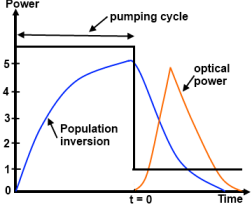
Q Switched Laser Operation Graph Here during the pumping cycle, when the Q – Switch is closed, energy is stored in the active medium. This results in tremendous rate of population inversion.
The Q – Switch is opened at t = 0 so the stimulated emission occurs at an accelerated rate and the laser output power or optical power increases rapidly. Once the power reaches to its peak value then it falls off almost very quickly.
Remember that Q – Switch laser pulses are characterized by extremely high amplitude and short duration.
Mode Locked Laser
when instead of Q – Switch the mode locker is added between mirrors then resultant laser is called mode locked laser.
the mode locker shutters open & close at a rate that is synchronized to the time it takes a pulse of light to make a complete round trip with in the laser cavity. This synchronized shutter locks together the longitudinal modes within the cavity.
The pulse width is extremely short usually in range of Pico seconds to Nano seconds in mode locked lasers.
Mode locked pulses can be produced in either pulse pumped or continuous pumped lasers. The output from these lasers may be single pulse or string of rapid pulses, as shown

Mode Locked Laser Since the time duration of mode locked pulse is too short, therefore extremely high peak power can be obtained.
